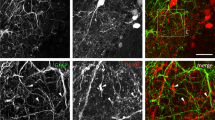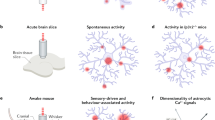Abstract
Release of ATP from astrocytes is required for Ca2+ wave propagation among astrocytes1,2,3 and for feedback modulation of synaptic functions2,4,5. However, the mechanism of ATP release and the source of ATP in astrocytes are still not known. Here we show that incubation of astrocytes with FM dyes leads to selective labelling of lysosomes. Time-lapse confocal imaging of FM dye-labelled fluorescent puncta, together with extracellular quenching and total-internal-reflection fluorescence microscopy (TIRFM), demonstrated directly that extracellular ATP or glutamate induced partial exocytosis of lysosomes, whereas an ischaemic insult with potassium cyanide induced both partial and full exocytosis of these organelles. We found that lysosomes contain abundant ATP, which could be released in a stimulus-dependent manner. Selective lysis of lysosomes abolished both ATP release and Ca2+ wave propagation among astrocytes, implicating physiological and pathological functions of regulated lysosome exocytosis in these cells.
This is a preview of subscription content, access via your institution
Access options
Subscribe to this journal
Receive 12 print issues and online access
$209.00 per year
only $17.42 per issue
Buy this article
- Purchase on Springer Link
- Instant access to full article PDF
Prices may be subject to local taxes which are calculated during checkout





Similar content being viewed by others
References
Guthrie, P. B. et al. ATP released from astrocytes mediates glial calcium waves. J. Neurosci. 19, 520–528 (1999).
Carmignoto, G. Astrocyte control of synaptic transmission and neurovascular coupling. Physiol. Rev. 86, 1009–1031 (2006).
Cotrina, M. L., Lin, J. H., Lopez-Garcia, J. C., Naus, C. C. & Nedergaard, M. ATP-mediated glia signaling. J. Neurosci. 20, 2835–2844 (2000).
Zhang, J. M. et al. ATP released by astrocytes mediates glutamatergic activity-dependent heterosynaptic suppression. Neuron 40, 971–982 (2003).
Pascual, O. et al. Astrocytic purinergic signaling coordinates synaptic networks. Science 310, 113–116 (2005).
Coco, S. et al. Storage and release of ATP from astrocytes in culture. J. Biol. Chem. 278, 1354–1362 (2003).
Blott, E. J. & Griffiths, G. M. Secretory lysosomes. Nature Rev. Mol. Cell Biol. 3, 122–131 (2002).
Gardella, S. et al. CD8+ T lymphocytes induce polarized exocytosis of secretory lysosomes by dendritic cells with release of interleukin-1β and cathepsin D. Blood 98, 2152–2159 (2001).
Jadot, M., Colmant, C., Wattiaux-De, C. S. & Wattiaux, R. Intralysosomal hydrolysis of glycyl-L-phenylalanine 2-naphthylamide. Biochem. J. 219, 965–970 (1984).
Klingauf, J., Kavalali, E. T. & Tsien, R. W. Kinetics and regulation of fast endocytosis at hippocampal synapses. Nature 394, 581–585 (1998).
Rizzoli, S. O., Richards, D. A. & Betz, W. J. Monitoring synaptic vesicle recycling in frog motor nerve terminals with FM dyes. J. Neurocytol. 32, 539–549 (2003).
Harata, N. C., Choi, S., Pyle, J. L., Aravanis, A. M. & Tsien, R. W. Frequency-dependent kinetics and prevalence of kiss-and-run and reuse at hippocampal synapses studied with novel quenching methods. Neuron 49, 243–256 (2006).
Hayashi, T., Shoji, M. & Abe, K. Molecular mechanisms of ischemic neuronal cell death—with relevance to Alzheimer's disease. Curr. Alzheimer Res. 3, 351–358 (2006).
Dubinsky, J. M. & Rothman, S. M. Extracellular calcium concentration during 'chemical hypoxia' and excitatoric neuronal injury. J. Neurosci. 11, 2545–2552 (1991).
Reddy, A., Caler, E. V. & Andrews, N. W. Plasma membrane repair is mediated by Ca2+-regulated exocytosis of lysosomes. Cell 106, 157–169 (2001).
Jaiswal, J. K., Chakrabarti, S., Andrews, N. W. & Simon, S. M. Synaptotagmin VII restricts fusion pore expansion during lysosomal exocytosis. PLoS Biol. 2, E233 (2004).
Heidemann, A. C., Schipke, C. G. & Kettenmann, H. Extracellular application of nicotinic acid adenine dinucleotide phosphate induces Ca2+ signaling in astrocytes in situ. J. Biol. Chem. 280, 35630–35640 (2005).
Chen, X., Wang, L., Zhou, Y., Zheng, L. H. & Zhou, Z. 'Kiss-and-run' glutamate secretion in cultured and freshly isolated rat hippocampal astrocytes. J. Neurosci. 25, 9236–9243 (2005).
Sorensen, C. E. & Novak, I. Visualization of ATP release in pancreatic acini in response to cholinergic stimulus. Use of fluorescent probes and confocal microscopy. J. Biol. Chem. 276, 32925–32932 (2001).
Sperlagh, B. & Vizi, S. E. Neuronal synthesis, storage and release of ATP. Semin. Neurosci. 8, 175–186 (1996).
Ballerini, P. et al. Glial cells express multiple ATP binding cassette proteins which are involved in ATP release. NeuroReport 13, 1789–1792 (2002).
Abraham, E. H. et al. The multidrug resistance (mdr1) gene product functions as an ATP channel. Proc. Natl Acad. Sci. USA 90, 312–316 (1993).
Eskelinen, E. L., Tanaka, Y. & Saftig, P. At the acidic edge: emerging functions for lysosomal membrane proteins. Trends Cell Biol. 13, 137–145 (2003).
Cabrita, M. A., Hobman, T. C., Hogue, D. L., King, K. M. & Cass, C. E. Mouse transporter protein, a membrane protein that regulates cellular multidrug resistance, is localized to lysosomes. Cancer Res. 59, 4890–4897 (1999).
Harikumar, P. & Reeves, J. P. The lysosomal proton pump is electrogenic. J. Biol. Chem. 258, 10403–10410 (1983).
Parkinson, F. E. & Xiong, W. Stimulus- and cell-type-specific release of purines in cultured rat forebrain astrocytes and neurons. J. Neurochem. 88, 1305–1312 (2004).
Duan, S. & Neary, J. P2X7/P2Z receptors: properties and relevance to CNS functions. Glia 54, 738–746 (2006).
Brake, A. J. & Julius, D. Signaling by extracellular nucleotides. Annu. Rev. Cell Dev. Biol. 12, 519–541 (1996).
Renger, J. J., Egles, C. & Liu, G. A developmental switch in neurotransmitter flux enhances synaptic efficacy by affecting AMPA receptor activation. Neuron 29, 469–484 (2001).
Jaiswal, J. K., Andrews, N. W. & Simon, S. M. Membrane proximal lysosomes are the major vesicles responsible for calcium-dependent exocytosis in nonsecretory cells. J. Cell Biol. 159, 625–635 (2002).
Acknowledgements
We thank M-m. Poo for critical comments on the manuscript, and Z. Zhou, X. K. Chen and Y. Zhou for valuable discussion. This work was supported by grants from the Major State Basic Research Program of China (G200077800 and 2006CB806600) and the National Natural Science Foundation of China (30321002).
Author information
Authors and Affiliations
Corresponding author
Ethics declarations
Competing interests
The authors declare no competing financial interests.
Supplementary information
Supplementary Information
Supplementary Figures 1, 2 and 3, Supplementary Movies 1, 2, 3 and 4 and Supplementary Methods (PDF 1160 kb)
Rights and permissions
About this article
Cite this article
Zhang, Z., Chen, G., Zhou, W. et al. Regulated ATP release from astrocytes through lysosome exocytosis. Nat Cell Biol 9, 945–953 (2007). https://doi.org/10.1038/ncb1620
Received:
Accepted:
Published:
Issue Date:
DOI: https://doi.org/10.1038/ncb1620
This article is cited by
-
The Purinergic System as a Target for the Development of Treatments for Bipolar Disorder
CNS Drugs (2022)
-
Astrocytes respond to a neurotoxic Aβ fragment with state-dependent Ca2+ alteration and multiphasic transmitter release
Acta Neuropathologica Communications (2021)
-
NG2 glia-derived GABA release tunes inhibitory synapses and contributes to stress-induced anxiety
Nature Communications (2021)
-
The ATP Level in the mPFC Mediates the Antidepressant Effect of Calorie Restriction
Neuroscience Bulletin (2021)
-
Quinacrine is not a vital fluorescent probe for vesicular ATP storage
Purinergic Signalling (2021)



